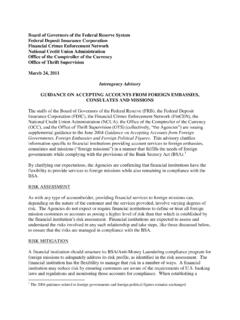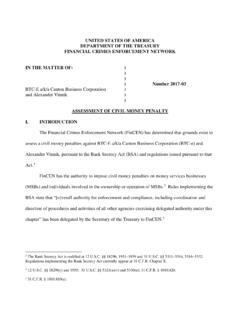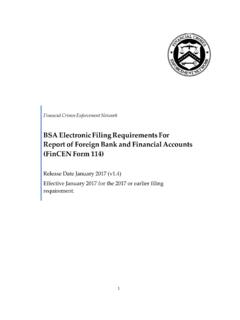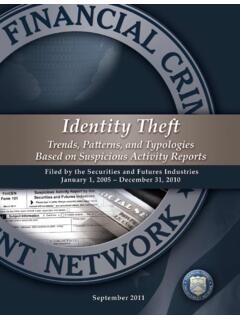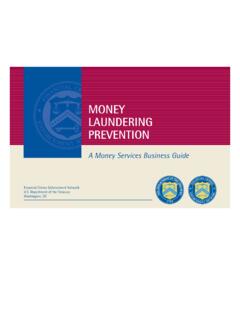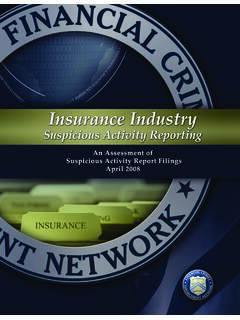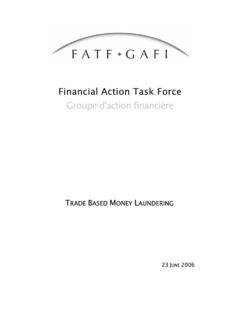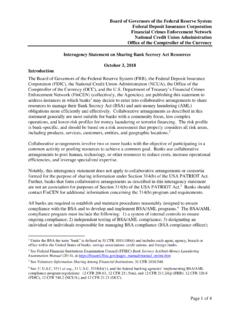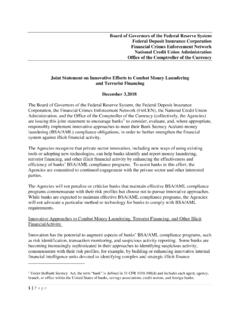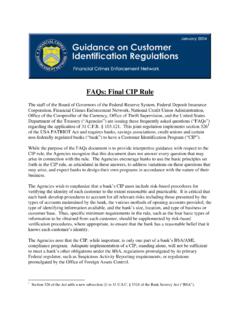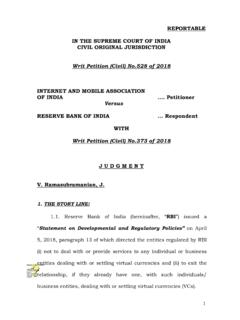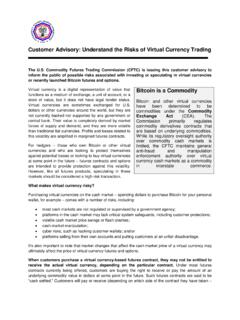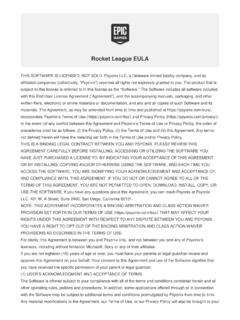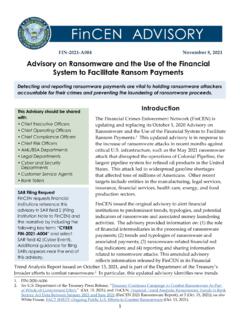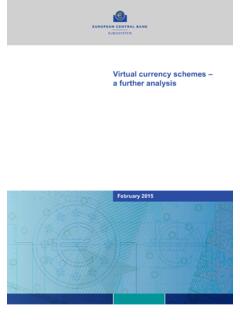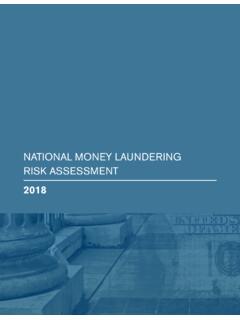Transcription of FIN-2020-A006 October 1, 2020 Advisory on Ransomware and ...
1 1 IntroductionThe Financial Crimes Enforcement Network (FinCEN) is issuing this Advisory to alert financial institutions to predominant trends, typologies, and potential indicators of Ransomware and associated money laundering activities. This Advisory provides information on: (1) the role of financial intermediaries in the processing of Ransomware payments; (2) trends and typologies of Ransomware and associated payments; (3) Ransomware -related financial red flag indicators; and (4) reporting and sharing information related to Ransomware information contained in this Advisory is derived from FinCEN s analysis of cyber- and Ransomware -related Bank Secrecy Act (BSA) data, open source reporting, and law enforcement is a form of malicious software ( malware ) designed to block access to a computer system or data, often by encrypting data or programs on information technology (IT) systems to extort ransom payments from victims in exchange for decrypting the information and restoring victims access to their systems or In some cases, in addition to the attack, the perpetrators threaten to publish sensitive files belonging to the victims, which can be individuals or business entities 1.
2 Both extortion and computer fraud and abuse are specified unlawful activities and predicate offenses to money laundering. See 18 USC 1956(c)(7). Advisory on Ransomware and the Use of the Financial System to Facilitate Ransom PaymentsDetecting and reporting Ransomware payments are vital to prevent and deter cybercriminals from deploying malicious software to extort individuals and businesses and hold Ransomware attackers accountable for their Advisory should be shared with: Chief Executive Officers Chief Operating Officers Chief Compliance Officers Chief Risk Officers Chief Information Officers AML/BSA Departments Legal Departments Cyber and Security Departments Customer Service Agents Bank TellersFIN-2020-A006 October 1, 2020 SAR Filing Request:FinCEN requests financial institutions reference this Advisory in SAR field 2 (Filing Institution Note to FinCEN) and the narrative by including the following key term: CYBER FIN-2020-A006 and select SAR field 42 (Cyber Event).
3 Additional guidance on filing SARs appears near the end of this ADVISORY2(including financial institutions). The consequences of a Ransomware attack can be severe and far-reaching with losses of sensitive, proprietary, and critical information and/or loss of business Role of Financial Intermediaries in Facilitating Ransomware PaymentsRansomware attacks are a growing concern for the financial sector because of the critical role financial institutions play in the collection of ransom payments. Processing Ransomware payments is typically a multi-step process that involves at least one depository institution and one or more money services business (MSB). Many Ransomware schemes involve convertible virtual currency (CVC), the preferred payment method of Ransomware perpetrators. Following the delivery of the ransom demand, a Ransomware victim will typically transmit funds via wire transfer, automated clearinghouse, or credit card payment to a CVC exchange to purchase the type and amount of CVC specified by the Ransomware perpetrator.
4 Next, the victim will send the CVC, often from a wallet hosted2 at the exchange, to the perpetrator s designated account or CVC address. The perpetrator then launders the funds through various means, including mixers and tumblers3 to convert funds into other CVCs, smurfing4 transactions across many accounts and exchanges, and/or moving the CVC to foreign-located exchanges and peer-to-peer (P2P) exchangers5 in jurisdictions with weak anti-money laundering and countering financing of terrorism (AML/CFT) controls. 2. Hosted wallets are CVC wallets where the CVC exchange receives, stores, and transmits the CVCs on behalf of their accountholders. See FinCEN Guidance, FIN-2019-G001, Application of FinCEN s Regulations to Certain Business Models Involving Convertible virtual Currencies, (May 9, 2019).3. Mixing or tumbling involves the use of mechanisms to break the connection between an address sending CVC and the addresses receiving Smurfing refers to a layering technique in money laundering that involves breaking total amounts of funds into smaller amounts to move through multiple accounts before arriving at the ultimate P2P exchangers are individuals or entities offering to exchange fiat currencies for virtual currencies or one virtual currency for another virtual currency .
5 P2P exchangers usually operate informally, typically advertising and marketing their services through online classified advertisements or fora, social media, and by word of mouth. See FinCEN Advisory , FIN-2019-A003, Advisory on Illicit Activity Involving Convertible virtual currency , (May 9, 2019).FINCEN ADVISORY3 Figure 1. Movement of CVC in Ransomware AttacksInvolvement of Digital Forensics and Incident Response and Cyber Insurance Companies in Ransomware PaymentsThe prevalence of Ransomware attacks has led to the creation of companies that provide protection and mitigation services to victims of Ransomware attacks. Among these entities are digital forensics and incident response (DFIR) companies and cyber insurance companies (CICs). Some DFIR companies and CICs, as well as some MSBs that offer CVCs, facilitate Ransomware payments to cybercriminals, often by directly receiving customers fiat funds, exchanging them for CVC, and then transferring the CVC to criminal-controlled accounts.
6 Depending on the particular facts and circumstances, this activity could constitute money transmission. Entities engaged in money services business activities (such as money transmission) are required to register as an MSB with FinCEN, and are subject to BSA obligations, including filing suspicious activity reports (SARs).6 Persons involved in Ransomware payments must also be aware of any Office of Foreign Assets Control (OFAC)-related obligations that may arise from that activity. Today, OFAC issued an Advisory highlighting the sanctions risks associated with facilitating Ransomware payments on behalf of victims targeted by malicious cyber-enabled See generally 31 Part 1022 and 31 CFR (ff).FINCEN ADVISORY4 Trends and Typologies of Ransomware and Associated PaymentsThe severity and sophistication of Ransomware attacks continue to rise7 across various sectors, particularly across governmental entities, and financial, educational, and healthcare Ransomware attacks on small municipalities and healthcare organizations have increased, likely due to the victims weaker cybersecurity controls, such as inadequate system backups and ineffective incident response using Ransomware often resort to common tactics, such as wide-scale phishing and targeted spear-phishing campaigns that induce victims to download a malicious file or go to a malicious site, exploit remote desktop protocol endpoints and software vulnerabilities, or deploy drive-by malware attacks that host malicious code on legitimate websites.
7 Proactive prevention through effective cyber hygiene, cybersecurity controls, and business continuity resiliency is often the best defense against Sophistication of Ransomware OperationsBig Game Hunting schemes : Ransomware actors are increasingly engaging in selective targeting of larger enterprises to demand bigger payouts commonly referred to as big game hunting. 11 Ransomware Criminals Forming Partnerships and Sharing Resources: Many cybercriminals are sharing resources to enhance the effectiveness of Ransomware attacks, such as Ransomware exploit kits that come with ready-made malicious codes and tools. These kits can be purchased, although they are also offered free of charge. Some Ransomware groups are also forming partnerships to share advice, code, trends, techniques, and illegally-obtained information over shared platforms. Double Extortion schemes : Ransomware criminals are increasingly engaging in double extortion schemes , which involve removing sensitive data from the targeted networks and encrypting the system files and demanding ransom.
8 The criminals then threaten to publish or sell the stolen data if the victim fails to pay the The Federal Bureau of Investigation (FBI) Internet Crime Complaint Center (IC3) received 37% more reports of Ransomware incidents in 2019 than in 2018, with a 46% increase in associated financial losses. BSA reporting shows a stark increase in financial losses per Ransomware incident, with the average dollar amount in financial institution SARs on Ransomware increasing approximately $87,000 from 2018 to 2019 ($417,000 to $504,000) and $280,000 from 2019 to thus far in 2020 ($504,000 to $783,000). See FBI IC3, 2019 Internet Crime Report, (2019); and FBI IC3, 2018 Internet Crime Report, (2018).8. See FinCEN Advisory , FIN-2020-A005, Advisory on Cybercrime and Cyber-Enabled Crime Exploiting the Coronavirus Disease 2019 (COVID-19) Pandemic, (July 30, 2020).9. Multi-State Information Sharing and Analysis Center (MS-ISAC), Security Primer Ransomware , (May 2020).
9 10. For more information about Ransomware risk, see Federal Financial Institutions Examination Council (FFIEC), Press Release, FFIEC Releases Statement on Cyber Attacks Involving Extortion, (November 3, 2015); Department of Homeland Security (DHS) Cybersecurity and Infrastructure Security Agency (CISA), Security Tip (ST19-001): Protecting against Ransomware , (April 11, 2019); and DHS CISA, MS-ISAC, National Governors Association (NGA), and National Association of State Chief Information Officers (NASCIO), Joint Alert, CISA, MS-ISAC, NGA & NASCIO Recommend Immediate Action to Safeguard against Ransomware , (July 29, 2019).11. See FBI Public Service Announcement, Alert No. I-100219-PSA, High-Impact Ransomware Attacks Threaten Businesses and Organizations, ( October 2, 2019).FINCEN ADVISORY5 Use of Anonymity-Enhanced Cryptocurrencies (AECs): Cybercriminals usually require Ransomware payments to be denominated in CVCs, most commonly in bitcoin (see Figure 1).
10 However, they are also increasingly requiring or incentivizing victims to pay in AECs that reduce the transparency of CVC financial flows, including Ransomware payments, through anonymizing features, such as mixing and cryptographic Some Ransomware operators have even offered discounted rates to victims who pay their ransoms in of Fileless Ransomware : Fileless Ransomware is a more sophisticated tool that can be challenging to detect because the malicious code is written into the computer s memory rather than into a file on a hard drive, which allows attackers to circumvent off-the-shelf antivirus and malware Red Flag Indicators of Ransomware and Associated PaymentsFinCEN has identified the following financial red flag indicators of Ransomware -related illicit activity to assist financial institutions in detecting, preventing, and reporting suspicious transactions associated with Ransomware attacks. As no single financial red flag indicator is indicative of illicit or suspicious activity, financial institutions should consider the relevant facts and circumstances of each transaction, in keeping with their risk-based approach to IT enterprise activity is connected to cyber indicators that have been associated with possible Ransomware activity or cyber threat actors known to perpetrate Ransomware schemes .
